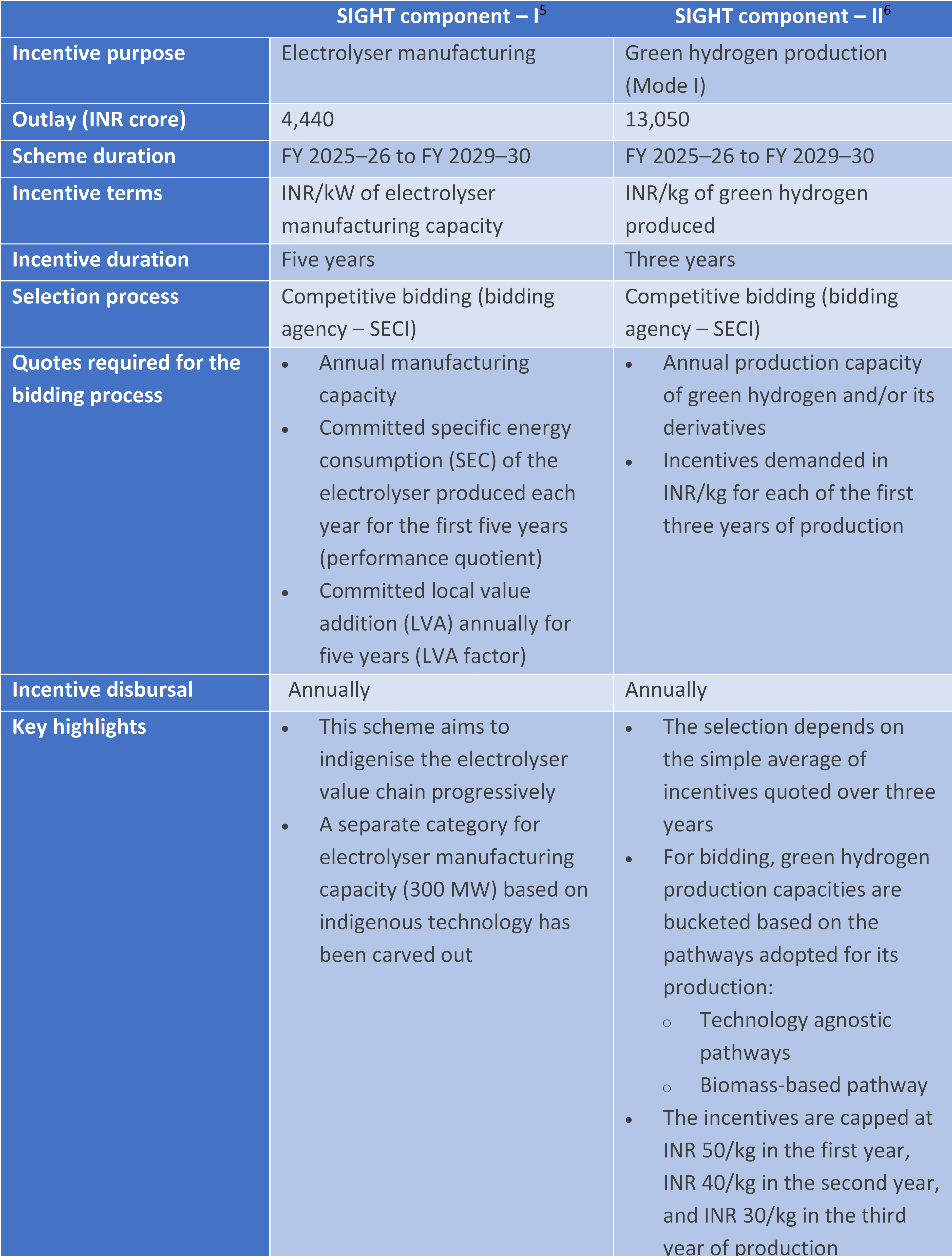Context
India's climate goals are well documented; they include (a) achieving net zero by 2070,1 (b) reducing the emissions intensity of its gross domestic product (GDP) by 45 per cent by 2030 compared to 2005 levels, and (c) transitioning 50 per cent of the total installed capacity to non-fossil-fuel-based energy resources by 2030.2 India also aims to become energy independent by 2047.1 Green hydrogen can play a catalytic role in fulfilling these goals.
Globally, the emphasis on utilising green hydrogen is ever-increasing. As of August 2022, 38 countries and the European Union (EU) have released green hydrogen policies and set targets for green hydrogen production and deployment of electrolysers.3
Similarly, in India, acknowledging the significance of green hydrogen, the Union Cabinet approved the National Green Hydrogen Mission (the Mission) in January 2023. The Mission's primary objectives are to position India as a global leader in producing, utilising, and exporting green hydrogen and its by-products.1 The Mission aims to facilitate the development of five million metric tonnes per annum of green hydrogen production capacity by 2030. The Ministry of New and Renewable Energy (MNRE) has allocated an initial budget of INR 19,744 crore for the Mission.4
As part of the Mission, a supply-side incentive programme – Strategic Interventions for Green Hydrogen Transition (SIGHT) – has been designed to stimulate the growth of the green hydrogen value chain in India. For the initial stage, two financial incentive schemes were outlined in the Mission’s blueprint:
- Support for domestic electrolyser manufacturing
- Support for domestic green hydrogen production
What are SIGHT components – I and II?
Following the approval of the Mission, MNRE released guidelines for implementing SIGHT programme components I5 and II6 in June 2023. Solar Energy Corporation of India (SECI) is the designated agency for implementing the schemes. The following section discusses the scheme guidelines for both components.
A) SIGHT component – I: Incentive scheme for electrolyser manufacturing
The objectives of this scheme are to (a) maximise indigenous electrolyser manufacturing capacity, (b) achieve lower levelised cost of hydrogen production, (c) ensure globally competitive performance and quality of products, (d) progressively enhance domestic value addition and (e) and provide support for established and promising electrolyser technologies. The scheme is applicable from FY 2025–26 to FY 2029–30, with a total outlay of INR 4,440 crore.
B) SIGHT component – II: Incentive scheme for green hydrogen production
This component focuses on incentivising green hydrogen production in India. The objectives are to (a) maximise the production of green hydrogen and its derivatives, (b) enhance the cost-competitiveness of green hydrogen versus its fossil-based alternatives, and (c) encourage large-scale utilisation of green hydrogen and its derivatives. It is applicable for the period from FY 2025–26 to FY 2029–30, with a total outlay of INR 13,050 crore. Two modes of implementation are identified under this scheme:
- Mode 1: Bidding on the least direct incentive demanded for the first three-year period (over which incentives are provided) through a competitive selection process.
- Mode 2: The implementing agency shall aggregate demand and call for bids for the procurement of green hydrogen and its derivatives at the lowest possible cost through a competitive selection process.
The present guidelines are outlined for green hydrogen production under Mode I.
Table 1: Details of SIGHT components I & II

Source: CEEW-CEF's compilation based on SIGHT scheme guidelines.
Who should care?
- Domestic and international green hydrogen producers
- Electrolyser manufacturers
- Energy-intensive industry players
- Renewable energy developers
- Investors/funding agencies
References
- [1] MNRE. 2023. National Green Hydrogen Mission. New Delhi: Ministry of New and Renewable Energy, Government of India. https://cdnbbsr.s3waas.gov.in/s3716e1b8c6cd17b771da77391355749f3/uploads/2023/01/2023012338.pdf.
- [2] PIB. 2022. “Union Cabinet Approved India’s Updated Nationally Determined Contribution (NDC).” Press Information Bureau, 3 August. https://pib.gov.in/PressReleaseIframePage.aspx?PRID=1847812.
- [3] Ghosh, Arunabha, Tulika Gupta, Shuva Raha, Hemant Mallya, Deepak Yadav, and Nandini Harihar. 2022. Rules for an Energy Secure Global Green Hydrogen Economy. New Delhi: Council on Energy, Environment and Water.
- [4] PIB. 2023. “Ministry of New and Renewable Energy Notifies National Green Hydrogen Mission.” Press Information Bureau, 4 January. https://pib.gov.in/PressReleasePage.aspx?PRID=1888547.
- [5] MNRE. 2023. “Scheme Guidelines for Implementation of ‘Strategic Interventions for Green Hydrogen Transition (SIGHT) Programme - Component I: Incentive Scheme for Electrolyser Manufacturing’ of the National Green Hydrogen Mission.” New Delhi: Ministry of New and Renewable Energy, Government of India. https://cdnbbsr.s3waas.gov.in/s3716e1b8c6cd17b771da77391355749f3/uploads/2023/07/2023072664.pdf.
- [6] MNRE. 2023. “Scheme Guidelines for Implementation of “Strategic Interventions for Green Hydrogen Transition (SIGHT) Programme - Component II: Incentive Scheme for Electrolyser Manufacturing” of the National Green Hydrogen Mission.” New Delhi: Ministry of New and Renewable Energy, Government of India. https://cdnbbsr.s3waas.gov.in/s3716e1b8c6cd17b771da77391355749f3/uploads/2023/07/2023072641.pdf.
